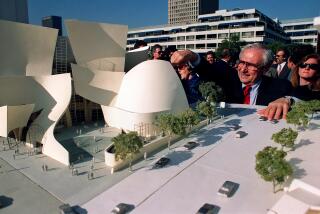Walt Disney Concert Hall’s organ conservator pulls out all the stops
- Share via
Frank Gehry refers to the flamboyant organ he designed for Walt Disney Concert Hall as the “French fries” because that’s what the largest of its 6,134 pipes resemble. Gehry designed the inimitable instrument in collaboration with builder Manuel Rosales and it debuted in 2004. Among its overseers is conservator Phil Smith, 61, who shows off the instrument to visitors. Smith, who grew up listening to organ music in church, is never too far away from work -- his downtown apartment has a view of Disney Hall.
What does it mean to be an organ conservator?
It’s an interesting title because I don’t really conserve anything, I show it off instead of conserve it.
How did you become interested in the organ?
My father being a pastor at a church and my mother being a pianist and singer. My mom taught me how to play piano at age 3 or 4 when she heard someone playing and walked in and saw me playing. It wasn’t one of her students, it was me playing what I heard her rehearsing with another student. From then on she taught me.
FULL COVERAGE: Walt Disney Concert Hall at 10
My father showed me an organ at some point and I thought I’d try it, I was 12 and pretty proficient piano-wise. After, I ran across the driveway and told my mom I wanted to play organ and she said, “OK, dinner is almost ready.”
What do you like about the instrument?
It’s the king of instruments. It’s the most complex and it’s the ultimate in power. When you pull out all the stops and play something tutti super fortissimo it’s unlike anything else. That’s when you find power in a way, when you’re seated in front of this enormous instrument and you’re using both hands, both feet, your whole body to play.
How does the Disney Hall organ compare to others?
I’ve played at many of the finest organs, in churches and concert halls in the United States and in the oldest churches in Europe and I’ve found that this one is the right size, with the right accents and nuances. I’ve done guest recitals on instruments four times its size, but I keep coming back. The way it builds and dissipates out, it’s remarkable.
TIMELINE: Walt Disney Hall through the years
What’s the coolest part of your job?
We take people on tours inside the organ and having the opportunity to see the mechanism, or the strikers when the organ is being played, to see the outside from inside and the blowers, the wind lines, all of this. And it’s so expansive, it’s 40 to 45 feet tall and its weight is so vast. Seeing all that from within is wonderful.
How do people react to the view from inside?
They’re in awe, even for organists, some have never seen inside their instrument before and when they see it they say, “Wow.”
All these different kinds of pipes produce different sounds and it’s fun to show. It’s really great to show and tell in that way.
How are you celebrating the organ this year?
This is the ninth year for the organ. Next year we’ll celebrate the 10th year and we’ll be able to pull out all the stops for that.
What is your favorite piece to play on the organ?
I have a few party pieces as I like to call them. I love Bach, all the major parts he writes and as an organist I just love playing them. And I grew up in the church, so many of them are familiar and just comforting to me.
The organ is so easily used as a testing ground for orchestral works and composers will transcribe orchestral pieces based on an original organ book. For a long time cities that didn’t have orchestras would look to an organist because the organ is like so many instruments in one.
Do you think organ music is still relevant today?
There are always more people wanting to hear than can fit in the concert hall, so I think that’s pretty telling.
More to Read
The biggest entertainment stories
Get our big stories about Hollywood, film, television, music, arts, culture and more right in your inbox as soon as they publish.
You may occasionally receive promotional content from the Los Angeles Times.










